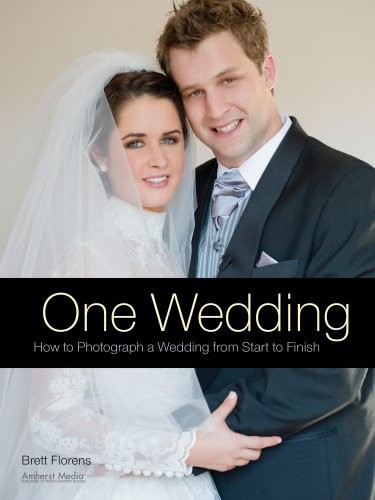 One Wedding: How to Photograph a Wedding from Start to Finish by Brett Florens is a look at one professional wedding photographer’s approach to serving his customer’s needs. Published earlier this year in May 2014, Florens was probably using the techniques and processes described here at least as recently as early 2013. So as of now, it’s reasonably current. For professional photographers, that’s important. Though Florens makes no reference to the timeliness of his advice.
One Wedding: How to Photograph a Wedding from Start to Finish by Brett Florens is a look at one professional wedding photographer’s approach to serving his customer’s needs. Published earlier this year in May 2014, Florens was probably using the techniques and processes described here at least as recently as early 2013. So as of now, it’s reasonably current. For professional photographers, that’s important. Though Florens makes no reference to the timeliness of his advice.
The book chronicles the wedding photography experience of one couple, Chris & Claire. So, it’s literally one wedding. For newer photographers, drilling down into the operating specifics of one particular client is probably helpful. But, how many Chris & Claire’s are out there? The process Florens describes for this particular couple is grueling and exhaustive, not just for himself, but for his clients as well.
Florens’ ideology around wedding photography is tightly connected to the wedding album. Or, the “Storybook” as he calls it. Florens sees the book as his primary deliverable and whatever time he spent on the wedding day shooting was an input necessary to that end. His clients don’t hire a photographer, they commission a book and the photographer does whatever he needs to do to create it.
The Album vs The Hours is a bit of an ongoing debate within the wedding photography industry. And it’s added to a long list of others. Fillm vs Digital, Disc vs Album, Hourly vs Day Rate, To Freebie vs Not to Freebie. Florens makes no reference to the debate. Indeed, it’s not directly relevant, but a book with a title like “How to Photograph a Wedding From Start to Finish”, I feel, owes it to the reader to point out things that can’t be understood in such general terms.
In working with Chris & Claire, Florens created his storybook across three sessions. The engagement session, the wedding day, and a post wedding shoot with the bride and groom back in their wedding attire.
Florens goes into satisfying detail about the ins and outs of setting up the engagement session. He describes using social media to learn about his clients and get a sense of what they like so that he can design a visual style that reflects their interest. He fills the engagement session with props sourced and borrowed from local vendors in trade. With Chris & Clair he sets up three scenes to photograph them in–one ‘bohemian’ with natural light, one outdoorsy with a preppy ad-vibe, and the third magazine high-fashion. In total, it represents the better part of a days work.
On the wedding day, Florens rounds up all the guys early in the morning for a casual session, having them play games on the beach and pose for shots. He does something similar with the ladies, except involving more makeup and giggles. He’ll bring them all back together about half a dozen more times before the reception starts. After the ceremony, he’ll get all the guests to pose for a photo, then he’ll do it again during the reception. Florens says his day at the wedding will last around 16 hours.
Finally, on a post wedding shoot, Florens will have the bride & groom return to their wedding get-up and do some more shots tailored to the couple’s taste. This section almost seems like an afterthought as he doesn’t mention the practicalities of redoing hair and makeup or location scouting as he did for the previous sessions. In Chris & Claire’s case, the session involved Claire’s ‘favorite‘ horse. Personally, I don’t know anyone who knows enough horses to have a favorite, which leads me to believe that Claire’s parents are very wealthy.
My Take Away
I picked up One Wedding in part because I needed something light to read (Marriage, A History kicked my ass), and because I realize it’d been years since I last read anything aimed specifically at broadly improving the main expression of my craft. Peering into another photographer’s workflow was bound to be insightful.
As I closed the book, I felt a tinge of jealousy knowing that Florens almost certainly commands a price for his service that makes mine look like a drop in a very big bucket. Without a doubt, that allows him to explore creative expression more directly in his work with clients. That’s cool. But for the average working photographer, that’s not very realistic. As I said, how many Chris & Claire’s are out there?
What is of greater value in this book, I think, is in the demonstration of variety with which wedding photographer’s can operate. Florens spends a ridiculous amount of time posing with his subjects. He can do that, he’s looking for clients who like to do that. But a photographer could choose not to do formals or posing at all–as long as they can find clients who also like that.
I think for photographers just starting out–those who are probably most attracted to a book with a title like this–the advice here is impractical. And, since it doesn’t provide any larger context on how the range of photographer’s serve clients, it might even be discouraging.

Recent Discussion